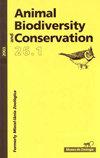“有些人喜欢它是外星人”:城市地区长耳猫头鹰对入侵环颈长尾小鹦鹉的捕食
IF 1
4区 环境科学与生态学
Q3 BIODIVERSITY CONSERVATION
引用次数: 7
摘要
本地物种的捕食压力可能会限制外来入侵物种的传播,从而在管理策略的影响和实施中发挥关键作用。krameri环颈长尾小鹦鹉是欧洲分布最广的外来鸟类之一,有近70个固定种群。这个物种的捕食者包括昼行性猛禽、合栖鸦类和啮齿动物。在这里,我们首次报道了长耳猫头鹰可能在它们的夜间栖息地捕食长尾小鹦鹉。167粒猫头鹰食粒的分析表明,环颈长尾小鹦鹉占环颈长尾小鹦鹉冬季食粮总量的10%以上(占绝对频率的32.93%),是环颈长尾小鹦鹉继鼠类和雀形目鸟类之后最重要的猎物种类。需要进一步的研究来调查长耳猫头鹰食用长尾小鹦鹉是否只是局部现象,还是在欧洲城市普遍存在。如果是这样的话,长耳猫头鹰的捕食可能最终导致长尾小鹦鹉受到某种形式的控制,并可能限制这种引入的长尾小鹦鹉对本地生物多样性的影响。本文章由计算机程序翻译,如有差异,请以英文原文为准。
'Some like it alien': predation on invasive ring–necked parakeets by the long–eared owl in an urban area
Predation pressure by native species may limit the spread of alien invasive species, thus playing a pivotal role in the impact and implementation of management strategies. The ring–necked parakeet Psittacula krameri is one of the most widespread alien bird species in Europe, with nearly 70 established populations. Predators of this species include diurnal raptors, synanthropic corvids, and rodents. Here we report for the first time that long–eared owls Asio otus might have preyed upon parakeets in their night roosts. Analysis of 167 owl pellets showed that ring–necked parakeets made up over 10 % of the total volume of the diet of these owls in winter (32.93 % of absolute frequency), representing the most important prey species after murid rodents and passerine birds. Further studies are needed to investigate whether parakeet consumption by long–eared owls is only a local occurrence or whether it is widespread in European cities. If so, predation by long–eared owl may eventually lead to a form of parakeet control and may limit the impact of this introduced parakeet on native biodiversity.
求助全文
通过发布文献求助,成功后即可免费获取论文全文。
去求助
来源期刊

Animal Biodiversity and Conservation
农林科学-动物学
CiteScore
2.00
自引率
0.00%
发文量
21
审稿时长
>12 weeks
期刊介绍:
Animal Biodiversity and Conservation (antes Miscel·lània Zoològica) es una revista interdisciplinar, publicada desde 1958 por el Museu de Ciències Naturals de Barcelona. Incluye artículos de investigación empírica y teórica en todas las áreas de la zoología (sistemática, taxonomía, morfología, biogeografía, ecología, etología, fisiología y genética) procedentes de todas las regiones del mundo. La revista presta especial interés a los estudios que planteen un problema nuevo o introduzcan un tema nuevo, con hipòtesis y prediccions claras, y a los trabajos que de una manera u otra tengan relevancia en la biología de la conservación. No se publicaran artículos puramente descriptivos, o artículos faunísticos o corológicos en los que se describa la distribución en el espacio o en el tiempo de los organismes zoológicos.
 求助内容:
求助内容: 应助结果提醒方式:
应助结果提醒方式:


